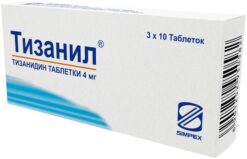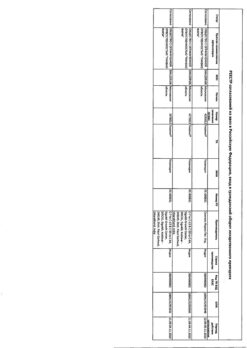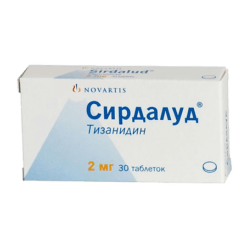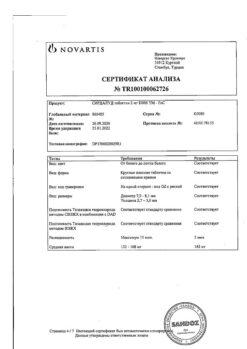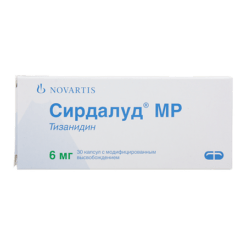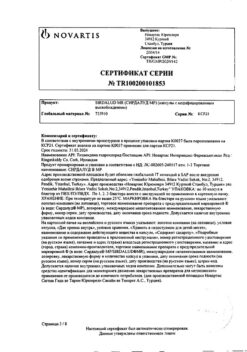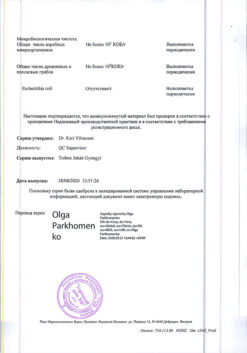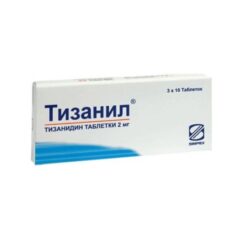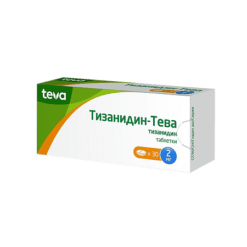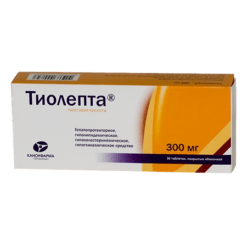No products in the cart.
Tizanidin-SZ, tablets 4 mg 30 pcs
€1.00
Out of stock
(E-mail when Stock is available)
Description
Pharmacotherapeutic group:Myorelaxant of central action
ATX code: M03BX02
Pharmacological properties
Pharmacodynamics
Tizanidine is a centrally acting myorelaxant; its main point of action is in the spinal cord. By stimulating presynaptic alpha2 receptors it inhibits the release of excitatory amino acids that stimulate receptors for N-methyl-D-aspartate (NMDA-receptors). As a consequence, polysynaptic transmission of excitation is suppressed at the level of intermediate neurons of the spinal cord. Since it is this mechanism that is responsible for excessive muscle tone, when it is suppressed, muscle tone is reduced. In addition to its myorelaxant properties, tizanidine also has a central moderately pronounced analgesic effect.
The drug Tizanidine-SZ is effective both in acute painful muscle spasm and in chronic spasticity of spinal and cerebral genesis. It reduces spasticity and clonic convulsions, as a result of which resistance to passive movements decreases and the volume of active movements increases.
The myorelaxant affect (as measured by the Ashworth scale and the pendulum test) and adverse effects (decrease in heart rate (HR) and blood pressure (BP)) of the drug depend on the plasma concentration of tizanidine.
Pharmacokinetics
.Absorption
Tizanidine is absorbed rapidly and almost completely. Maximum plasma concentration (Cmah) is reached approximately 1 hour after drug administration. Due to the pronounced metabolism during the “first passage” through the liver, the average bioavailability is about 34%. Cmah tizanidine is 12.3 ng/ml and 15.6 ng/ml after single and multiple tizanidine doses of 4 mg, respectively.
Distribution
The average volume of distribution in equilibrium with intravenous administration is 2.6 L/kg. Binding to plasma proteins is 30%.
Metabolism
Tnzanidine is rapidly and largely (about 95%) metabolized in the liver. In vitro tizanidine is metabolized mainly by CYP1A2 isoenzyme of cytochrome P450 system. Metabolites are inactive.
Elimation
The average elimination half-life of tizanidine from systemic blood flow is 2-4 h, excretion is mainly by kidneys (about 70% of dose) as metabolites; unchanged substance makes up about 4.5%.
Effects of food
Contemporaneous intake of food has no effect on pharmacokinetics of tizanidine (when using 4 mg as tablets or 12 mg as modified-release capsules). Although the Cmah value increases by 1/3 when taken after meals, this is not clinically significant. There is no significant effect on absorption (AUC, area under the pharmacokinetic concentration-time curve).
Tizanidine in the dose range from 1 mg to 20 mg has linear pharmacokinetics.
Peculiarities of pharmacokinetics in selected patient groups
Patients with impaired renal function
In patients with impaired renal function (creatinine clearance (CK) ≤
25 mL/min) Cmah tizanidine in plasma is 2 times higher than in healthy volunteers, with a final half-life of 14 hours, resulting in increased (approximately 6-fold) systemic bioavailability of tizanidine (measured by AUC).
Patients with impaired hepatic function
There have been no special studies in patients in this category. Since tizanidine is primarily metabolized in the liver by the cytochrome system CYP1A2 isoenzyme, impairment of liver function may increase the systemic exposure to the drug.
Patients older than 65 years
There are limited data on pharmacokinetics in patients in this group.
Dependence on gender and race
Gender has no effect on the pharmacokinetic properties of tizanidine.
The effect of ethnicity and race on the pharmacokinetics of tizanidine has not been studied.
Indications
Indications
Painful muscle spasm:
associated with static and functional diseases of the spine (cervical and lumbar syndromes);
after surgery, for example, for a herniated disc or osteoarthritis of the hip joint.
Spasticity of skeletal muscles in neurological diseases, for example, multiple sclerosis, chronic myelopathy, degenerative diseases of the spinal cord, consequences of cerebrovascular accidents and cerebral palsy (patients over 18 years of age).
Pharmacological effect
Pharmacological effect
Pharmacotherapeutic group: centrally acting muscle relaxant
ATX code: М03ВХ02
Pharmacological properties
Pharmacodynamics
Tizanidine is a centrally acting muscle relaxant. The main point of action is in the spinal cord. By stimulating presynaptic alpha2 receptors, it inhibits the release of excitatory amino acids that stimulate N-methyl-D-aspartate receptors (NMDA receptors). As a result, polysynaptic transmission of excitation is suppressed at the level of interneurons of the spinal cord. Since it is this mechanism that is responsible for excess muscle tone, when it is suppressed, muscle tone decreases. In addition to muscle relaxant properties, tizanidine also has a moderate central analgesic effect.
The drug Tizanidine-SZ is effective both in acute painful muscle spasms and in chronic spasticity of spinal and cerebral origin. Reduces spasticity and clonic convulsions, as a result of which resistance to passive movements decreases and the range of active movements increases.
Muscle relaxant affect (measured using the Ashworth scale and the pendulum test) and side effects (decrease in heart rate (HR) and decrease in blood pressure (BP)) of the drug depend on the concentration of tizanidine in the blood plasma.
Pharmacokinetics
Suction
Tizanidine is absorbed quickly and almost completely. The maximum concentration in blood plasma (Cmax) is achieved approximately 1 hour after taking the drug. Due to the pronounced first-pass metabolism through the liver, the average bioavailability is about 34%. Cmax of tizanidine is 12.3 ng/ml and 15.6 ng/ml after single and multiple doses of tizanidine at a dose of 4 mg, respectively.
Distribution
The average volume of distribution at steady state after intravenous administration is 2.6 l/kg. Plasma protein binding is 30%.
Metabolism
Tnzanidine is rapidly and extensively (about 95%) metabolized in the liver. In vitro, tizanidine is metabolized mainly by the CYP1A2 isoenzyme of the cytochrome P450 system. Metabolites are inactive.
Removal
The average half-life of tizanidine from the systemic circulation is 2-4 hours, excretion is carried out mainly by the kidneys (approximately 70% of the dose) in the form of metabolites; the share of unchanged substance accounts for about 4.5%.
Food influence
Concomitant food intake does not affect the pharmacokinetics of tizanidine (when administered as 4 mg tablets or 12 mg modified-release capsules). Although the Cmax value increases by 1/3 when taken after meals, this is not clinically significant. There is no significant effect on absorption (AUC, area under the concentration-time pharmacokinetic curve).
Tizanidine in the dose range from 1 mg to 20 mg has linear pharmacokinetics.
Features of pharmacokinetics in certain groups of patients
Patients with impaired renal function
In patients with impaired renal function (creatinine clearance (CC) ≤
25 ml/min) Cmax of tizanidine in blood plasma is 2 times higher than in healthy volunteers, the terminal half-life reaches 14 hours, which leads to increased (about 6 times) systemic bioavailability of tizanidine (measured by AUC).
Patients with liver dysfunction
No special studies have been conducted in patients in this category. Since tizanidine is predominantly metabolized in the liver by the CYP1A2 isoenzyme of the cytochrome system, impaired liver function may lead to increased systemic exposure of the drug.
Patients over 65 years of age
Data on pharmacokinetics in patients in this group are limited.
Dependence on gender and race
Gender does not affect the pharmacokinetic properties of tizanidine.
The influence of ethnicity and race on the pharmacokinetics of tizanidine has not been studied.
Special instructions
Special instructions
Hypotension may occur during the use of the drug Tizanidine-SZ, as well as as a result of drug interactions with inhibitors of the CYP1A2 isoenzyme and/or antihypertensive drugs. A pronounced decrease in blood pressure can lead to loss of consciousness and circulatory collapse.
Cases of liver dysfunction associated with tizanidine have been reported, but these cases are rare at daily doses up to 12 mg. In this regard, it is recommended to monitor liver function tests once a month in the first 4 months of treatment in patients receiving tizanidine at a daily dose of 12 mg or higher, as well as in cases where clinical signs suggestive of impaired liver function are observed, such as unexplained nausea, anorexia, and fatigue. If the activity of alanine aminotransferase (ALT) and aspartate aminotransferase (AST) in the serum persistently exceeds the upper limit of normal by 3 times or more, the use of the drug Tizanidine-SZ should be discontinued.
Contraception
Patients with preserved reproductive potential should be informed about the adverse effects of the drug on the developing fetus identified in animal studies. While using the drug, as well as for 1 day after stopping the drug, patients with preserved reproductive potential should use reliable methods of contraception (with correct and long-term use of which the pregnancy rate is <1%).
Impact on the ability to drive vehicles and machinery
Patients who experience drowsiness, dizziness, or any signs of arterial hypotension while using the drug should be advised to refrain from activities that require a high concentration of attention and quick reaction, for example, driving vehicles and machinery.
Active ingredient
Active ingredient
Tizanidine
Composition
Composition
1 tablet contains:
active ingredient:
tizanidine hydrochloride – 4.576 mg in terms of tizanidine – 4 mg;
excipients:
lactose monohydrate – 140.0 mg;
microcrystalline cellulose 102 – 129.824 mg;
colloidal silicon dioxide (Aerosil) – 2.8 mg;
magnesium stearate – 2.8 mg.
Pregnancy
Pregnancy
Pregnancy
Since there are no controlled studies of tizanidine in pregnant women, it should not be used during pregnancy unless the potential benefit outweighs the potential risk.
Animal studies have not revealed teratogenicity. When used in doses of 10 and 30 mg/kg per day, an increase in gestational age was observed in animals, cases of prenatal and postnatal fetal loss, as well as delayed fetal development, were recorded. When using the above doses, females showed pronounced signs of muscle relaxation and sedation. Based on body surface area, these doses exceeded the maximum recommended dose for humans
(0.72 mg/kg per day) by 2.2 and 6.7 times.
Breast-feeding
In animal studies, tizanidine was excreted in small amounts in the milk of lactating females. The drug should not be used during breastfeeding, since there is no data on the penetration of tizanidine into breast milk in humans.
Pregnancy test
Before starting the use of Tizanidine-SZ in patients with preserved reproductive potential, it is recommended to obtain the result of a pregnancy test.
Effect on fertility
In animal studies, no adverse effects on male or female fertility were observed when tizanidine was administered at doses of 10 mg/kg per day and 3 mg/kg/day, respectively. There was a decrease in fertility in males receiving tizanidine at a dose exceeding 30 mg/kg per day, and in females at a dose exceeding 10 mg/kg per day. Based on body surface area, these doses exceeded the maximum recommended dose for humans (0.72 mg/kg per day) by 2.2 and 6.7 times. Behavioral effects and clinical signs, including severe sedation, weight loss, and ataxia, were observed in the mother at these doses.
Contraindications
Contraindications
Hypersensitivity to tizanidine or any other component of the drug.
Severe liver dysfunction.
Concomitant use with potent inhibitors of the CYP1A2 isoenzyme, such as fluvoxamine or ciprofloxacin.
Not recommended for patients with rare hereditary diseases, such as lactase deficiency, lactose intolerance, glucose-galactose malabsorption, since the dosage form contains lactose.
Experience with the drug in patients under 18 years of age is limited. The use of Tizanidine-SZ in patients in this population is not recommended.
With caution
It is recommended to exercise caution when using the drug in patients over 65 years of age, patients with impaired renal function, and patients with moderate liver dysfunction.
Caution must be exercised when using Tizanidine-SZ simultaneously with drugs that prolong the QT interval (for example, cisapride, amitriptyline, azithromycin).
Side Effects
Side Effects
When taking small doses recommended for relieving painful muscle spasms, drowsiness, increased fatigue, dizziness, dry mouth, decreased blood pressure, nausea, gastrointestinal disorders, and increased activity of liver transaminases were observed. Typically, the above-described adverse reactions are moderate and transient.
When taking higher doses recommended for the treatment of spasticity, the above HP occur more often and are more pronounced, but they rarely require discontinuation of the drug due to the severity of the PR. In addition, the following phenomena may occur: bradycardia, muscle weakness, insomnia, sleep disturbances, hallucinations, hepatitis.
Adverse reactions (AR) are grouped in accordance with the MedDRA classification of organs and organ systems, within each group they are listed in order of decreasing frequency of occurrence. To assess the frequency of HP development, the following criteria were used: very often (≥ 1/10); often (from ≥ 1/100, < 1/10); uncommon (≥ 1/1000, < 1/100); rarely
(≥ 1/10000, < 1/1000); very rare (< 1/10000), including isolated reports.
Nervous system disorders: very often – drowsiness, dizziness.
Mental disorders: often – insomnia, sleep disorders.
Cardiac disorders: uncommon – bradycardia.
Vascular disorders: often – decrease in blood pressure (in some cases pronounced, up to circulatory collapse and loss of consciousness).
Disorders of the digestive system: very often – gastrointestinal disorders, dry mouth; often – nausea.
Musculoskeletal and connective tissue disorders: very common – muscle weakness.
General disorders and disorders at the injection site: very often – increased fatigue.
Laboratory and instrumental data: often – increased activity of liver transaminases. With abrupt discontinuation of the drug Tizanidine-SZ after prolonged treatment and/or taking high doses of the drug (as well as after simultaneous use with antihypertensive drugs), the development of tachycardia and increased blood pressure was observed, which in some cases could lead to acute cerebrovascular accident, and therefore the dose of Tizanidine-SZ should be reduced gradually until the drug is completely discontinued.
Selected reports of HP based on data from use in clinical practice Since post-marketing reports of HP come voluntarily from a population of uncertain size, it is not possible to reliably estimate the frequency of their occurrence (frequency unknown).
Immune system disorders: hypersensitivity reactions, including anaphylactic reactions, angioedema and urticaria.
Mental disorders: hallucinations, confusion.
Nervous system disorders: dizziness.
Visual disturbances: blurred vision.
Disorders of the liver and biliary tract: hepatitis, liver failure.
Skin and subcutaneous tissue disorders: skin rash, erythema, itching, dermatitis.
General disorders and disorders associated with administration: asthenia, withdrawal syndrome.
If any of the side effects indicated in the instructions get worse, or you notice any other side effects not listed in the instructions, tell your doctor.
Interaction
Interaction
When using the drug Tizanidine-SZ with inhibitors of the CYP1A2 isoenzyme, an increase in the concentration of tizanidine in the blood plasma is possible. In turn, an increase in the concentration of tizanidine in the blood plasma can lead to symptoms of drug overdose, including prolongation of the QT(c) interval.
The simultaneous use of Tizanidine-SZ with inducers of the CYP1A2 isoenzyme may lead to a decrease in the concentration of tizanidine in the blood plasma, which may lead to a decrease in the therapeutic effect of the drug.
Contraindicated combinations with tizanidine
The simultaneous use of tizanidine with fluvoxamine or ciprofloxacin, inhibitors of the CYP1A2 isoenzyme, is contraindicated.
When tizanidine was used with fluvoxamine or ciprofloxacin, a 33-fold and 10-fold increase in tizanidine AUC was observed, respectively. The result of simultaneous use may be significant and prolonged hypotension accompanied by drowsiness, dizziness, and a decrease in the speed of psychomotor reactions (in some cases, up to circulatory collapse and loss of consciousness).
Not recommended combinations with tizanidine
It is not recommended to use tizanidine simultaneously with other inhibitors of the CYP1A2 isoenzyme – antiarrhythmic drugs (amiodarone, mexiletine, propafenone), cimetidine, some fluoroquinolones (enoxacin, pefloxacin, norfloxacin), rofecoxib, oral contraceptives, ticlopidine.
Combinations with tizanidine that require caution Caution must be exercised when co-administering Tizanidine-SZ with drugs that prolong the QT interval (for example, cisapride, amitriptyline, azithromycin).
Antihypertensive drugs
The simultaneous use of Tizanidine-SZ with antihypertensive drugs, including diuretics, can sometimes cause a pronounced decrease in blood pressure (in some cases, up to circulatory collapse and loss of consciousness) and bradycardia.
When the drug Tizanidine-SZ was abruptly discontinued after simultaneous use with antihypertensive drugs, the development of tachycardia and an increase in blood pressure was observed, which in some cases can lead to acute cerebrovascular accident.
Rifampicin
Simultaneous administration of tizanidine and rifampicin leads to a 50% decrease in the concentration of tizanidine in the blood plasma. As a result, the therapeutic effect of the drug may be reduced, which may be clinically significant for some patients. Long-term simultaneous use of rifampicin and tizanidine should be avoided; if this is not possible, careful selection of the dose of tizanidine (increase) is recommended.
Smoking tobacco
Systemic bioavailability of tizanidine in smoking patients (more than
10 cigarettes per day) is reduced by approximately 30%. Long-term drug therapy in patients in this category may require higher doses of tizanidine than the average therapeutic dose.
Alcohol
During drug therapy, alcohol should be avoided, as it may increase the likelihood of adverse events (for example, decreased blood pressure and lethargy). Tizanidine may enhance the depressant effect of alcohol on the central nervous system.
Other medicines
Sedatives, hypnotics (benzodiazepine, baclofen) and other drugs such as antihistamines may also increase the sedative effect of tizanidine. Avoid taking the drug with other alpha2-adrenergic agonists (eg, clonidine) due to the potential for increased hypotensive effects.
Overdose
Overdose
To date, there have been several reports of overdose with Tizanidine-SZ, including a case where the dose taken was
400 mg. In all cases, recovery was uneventful.
Symptoms: nausea, vomiting, decreased blood pressure, prolongation of the QT interval (c), dizziness, drowsiness, miosis, anxiety, respiratory depression, coma.
Treatment. To remove the drug from the body, repeated use of activated carbon is recommended. Forced diuresis may also speed up the elimination of tizanidine. Subsequently, symptomatic treatment is carried out.
Storage conditions
Storage conditions
In a place protected from light, at a temperature not exceeding 25 oC.
Keep out of the reach of children.
Shelf life
Shelf life
3 years.
Do not use after the expiration date stated on the package.
Manufacturer
Manufacturer
North Star NAO, Russia
Additional information
| Shelf life | 3 years. Do not use after the expiration date stated on the package. |
|---|---|
| Conditions of storage | In the dark place at a temperature not exceeding 25 oC. Keep out of reach of children. |
| Manufacturer | North Star NAO, Russia |
| Medication form | pills |
| Brand | North Star NAO |
Other forms…
Related products
Buy Tizanidin-SZ, tablets 4 mg 30 pcs with delivery to USA, UK, Europe and over 120 other countries.


